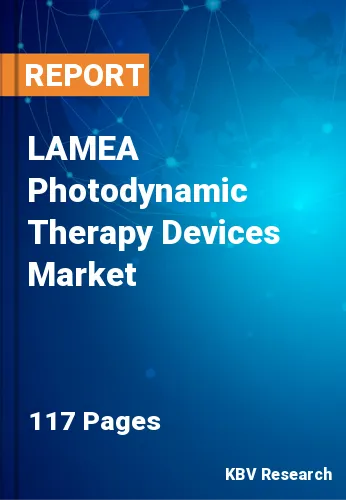The Latin America, Middle East and Africa Photodynamic Therapy Devices Market would witness market growth of 11.1% CAGR during the forecast period (2023-2030).
The expanding research and development in the analysis of photodynamic treatment present lucrative opportunities. The surge in demand for photosensitizer drugs and equipment for treating various cancer types is projected to drive market growth. PDT has shown promise in treating various cancers, including skin, lung, esophageal, and bladder. Its selective targeting ability minimizes damage to healthy tissues, reducing side effects commonly associated with traditional cancer therapies. In dermatology, PDT treats skin conditions such as actinic keratosis, acne, and certain skin cancers. The non-invasive nature of PDT makes it an attractive option for dermatological applications. PDT is employed in treating certain eye diseases, including age-related macular degeneration (AMD) and certain types of intraocular tumors. Its targeted approach is particularly advantageous in preserving surrounding healthy tissues.
Photodynamic therapy is being explored as a potential treatment for infectious diseases, including antibiotic-resistant infections. Photosensitizing agents can selectively target and eliminate microbial pathogens. In dentistry, PDT is used for periodontal disease treatment and disinfection. The antimicrobial properties of PDT contribute to its effectiveness in eliminating bacteria associated with oral infections. The market is noticing a surge in technological advances, leading to the development of more efficient and user-friendly devices. Innovations in light sources, photosensitizers, and delivery systems enhance treatment outcomes and patient experiences.
As per the Saudi Arabian Monetary Agency, by the end of 2050, 25 percent of Saudi Arabia's total population of 40 million is projected to be 60 or older. Additionally, it is anticipated that during the same period, the population of individuals aged 80 or older will increase by 1.6 million, or 4% of the overall populace. Aging is associated with dermatological concerns like wrinkles, sunspots, and skin laxity. PDT, with its applications in cosmetic dermatology, addresses these concerns, contributing to its adoption among the aging population. Thus, the above aspects will expand the market growth across the region in the upcoming years.
The Brazil market dominated the LAMEA Photodynamic Therapy Devices Market, By Country in 2022, and would continue to be a dominant market till 2030; thereby, achieving a market value of $19.3 million by 2030. The Argentina market is exhibiting a CAGR of 11.7% during (2023 - 2030). Additionally, The UAE market would experience a CAGR of 10.8% during (2023 - 2030).
Free Valuable Insights: The Worldwide Photodynamic Therapy Devices Market is Projected to reach USD 980.8 Million by 2030, at a CAGR of 8.5%
Based on End-use, the market is segmented into Hospitals, Clinics & Dermatology Centers, and Others. Based on Product, the market is segmented into Diode Lasers, and Disposable Fiber Optic Light Delivery Devices. Based on Application, the market is segmented into Cancer, Actinic Keratosis, Acne, Psoriasis, and Others. Based on countries, the market is segmented into Brazil, Argentina, UAE, Saudi Arabia, South Africa, Nigeria, and Rest of LAMEA.
By End-use
By Product
By Application
By Country
Our team of dedicated experts can provide you with attractive expansion opportunities for your business.

